Related Research Articles
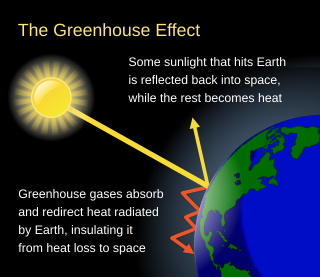
The greenhouse effect occurs when greenhouse gases in a planet's atmosphere insulate the planet from losing heat to space, raising its surface temperature. Surface heating can happen from an internal heat source as in the case of Jupiter, or from its host star as in the case of the Earth. In the case of Earth, the Sun emits shortwave radiation (sunlight) that passes through greenhouse gases to heat the Earth's surface. In response, the Earth's surface emits longwave radiation that is mostly absorbed by greenhouse gases. The absorption of longwave radiation prevents it from reaching space, reducing the rate at which the Earth can cool off.
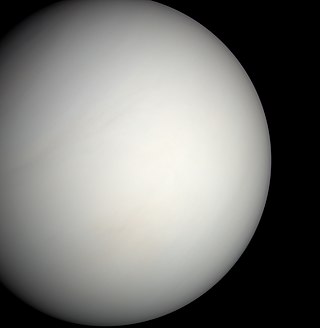
Venus is the second planet from the Sun. It is a terrestrial planet and is the closest in mass and size to its orbital neighbour Earth. Venus has by far the densest atmosphere of the terrestrial planets, composed mostly of carbon dioxide with a thick, global sulfuric acid cloud cover. At the surface it has a mean temperature of 737 K and a pressure 92 times that of Earth's at sea level. These extreme conditions compress carbon dioxide into a supercritical state at Venus's surface.
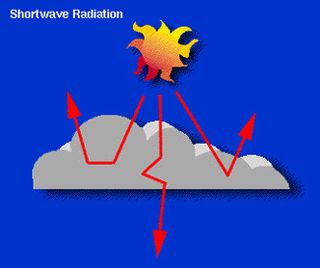
Cloud feedback is a type of climate change feedback, where the overall cloud frequency, height, and the relative fraction of the different types of clouds are altered due to climate change, and these changes then affect the Earth's energy balance. On their own, clouds are already an important part of the climate system, as they consist of water vapor, which acts as a greenhouse gas and so contributes to warming; at the same time, they are bright and reflective of the Sun, which causes cooling. Clouds at low altitudes have a stronger cooling effect, and those at high altitudes have a stronger warming effect. Altogether, clouds make the Earth cooler than it would have been without them.

The Discovery Program is a series of Solar System exploration missions funded by the U.S. National Aeronautics and Space Administration (NASA) through its Planetary Missions Program Office. The cost of each mission is capped at a lower level than missions from NASA's New Frontiers or Flagship Programs. As a result, Discovery missions tend to be more focused on a specific scientific goal rather than serving a general purpose.
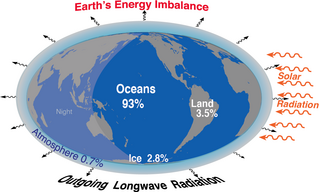
Earth's energy budget is the balance between the energy that Earth receives from the Sun and the energy the Earth loses back into outer space. Smaller energy sources, such as Earth's internal heat, are taken into consideration, but make a tiny contribution compared to solar energy. The energy budget also takes into account how energy moves through the climate system. The Sun heats the equatorial tropics more than the polar regions. Therefore, the amount of solar irradiance received by a certain region is unevenly distributed. As the energy seeks equilibrium across the planet, it drives interactions in Earth's climate system, i.e., Earth's water, ice, atmosphere, rocky crust, and all living things. The result is Earth's climate.

Akatsuki, also known as the Venus Climate Orbiter (VCO) and Planet-C, was a Japan Aerospace Exploration Agency (JAXA) space probe tasked with studying the atmosphere of Venus. It was launched aboard an H-IIA 202 rocket on 20 May 2010, but failed to enter orbit around Venus on 6 December 2010. After the craft orbited the Sun for five years, engineers successfully placed it into an alternative Venusian elliptic orbit on 7 December 2015 by firing its attitude control thrusters for 20 minutes and made it the first Japanese satellite orbiting Venus.

Observations of the planet Venus include those in antiquity, telescopic observations, and from visiting spacecraft. Spacecraft have performed various flybys, orbits, and landings on Venus, including balloon probes that floated in the atmosphere of Venus. Study of the planet is aided by its relatively close proximity to the Earth, compared to other planets, but the surface of Venus is obscured by an atmosphere opaque to visible light.
The New Frontiers program is a series of space exploration missions being conducted by NASA with the purpose of furthering the understanding of the Solar System. The program selects medium-class missions which can provide high science returns.

The atmosphere of Venus is the very dense layer of gases surrounding the planet Venus. Venus's atmosphere is composed of 96.5% carbon dioxide and 3.5% nitrogen, with other chemical compounds present only in trace amounts. It is much denser and hotter than that of Earth; the temperature at the surface is 740 K, and the pressure is 93 bar (1,350 psi), roughly the pressure found 900 m (3,000 ft) under water on Earth. The atmosphere of Venus supports decks of opaque clouds of sulfuric acid that cover the entire planet, preventing optical Earth-based and orbital observation of the surface. Information about surface topography has been obtained exclusively by radar imaging.

Venera-D is a proposed Russian space mission to Venus that would include an orbiter and a lander to be launched in 2031. The orbiter's prime objective is to perform observations with the use of a radar. The lander, based on the Venera design, would be capable of operating for a long duration on the planet's surface. The "D" in Venera-D stands for "dolgozhivuschaya," which means "long lasting" in Russian.

The possibility of life on Venus is a subject of interest in astrobiology due to Venus' proximity and similarities to Earth. To date, no definitive evidence has been found of past or present life there. In the early 1960s, studies conducted via spacecraft demonstrated that the current Venusian environment is extreme compared to Earth's. Studies continue to question whether life could have existed on the planet's surface before a runaway greenhouse effect took hold, and whether a relict biosphere could persist high in the modern Venusian atmosphere.
Io Volcano Observer (IVO) is a proposed low-cost mission to explore Jupiter's moon Io to understand tidal heating as a fundamental planetary process. The main science goals are to understand (A) how and where tidal heat is generated inside Io, (B) how tidal heat is transported to the surface, and (C) how Io is evolving. These results are expected to have direct implications for the thermal history of Europa and Ganymede as well as provide insights into other tidally heated worlds such as Titan and Enceladus. The IVO data may also improve our understanding of magma oceans and thus the early evolution of the Earth and Moon.
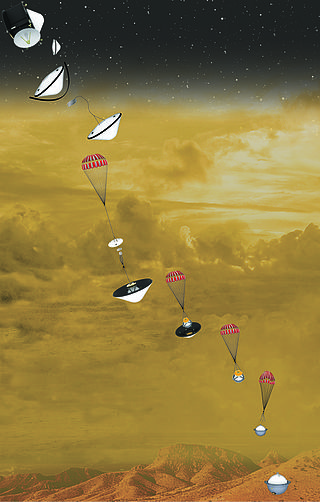
DAVINCI is a planned mission for an orbiter and atmospheric probe to the planet Venus. Together with the separate VERITAS mission, which will also study Venus, it was selected by NASA on June 2, 2021 to be part of their Discovery Program. Its acronym is inspired by Leonardo da Vinci in honor of his scientific innovations, aerial sketches and constructions.

Plankton, Aerosol, Cloud, ocean Ecosystem (PACE) is a 2020s NASA Earth-observing satellite mission to observe global ocean color, biogeochemistry, and ecology, as well as the carbon cycle, aerosols and clouds. PACE is intended to be used to identify the extent and duration of phytoplankton blooms and improve understanding of air quality. These and other uses of PACE data are expected to benefit the economy and society according to NASA, especially sectors that rely on water quality, fisheries and food security.

The Double Asteroid Redirection Test (DART) was a NASA space mission aimed at testing a method of planetary defense against near-Earth objects (NEOs). It was designed to assess how much a spacecraft impact deflects an asteroid through its transfer of momentum when hitting the asteroid head-on. The selected target asteroid, Dimorphos, is a minor-planet moon of the asteroid Didymos; neither asteroid poses an impact threat to Earth, but their joint characteristics made them an ideal benchmarking target. Launched on 24 November 2021, the DART spacecraft successfully collided with Dimorphos on 26 September 2022 at 23:14 UTC about 11 million kilometers from Earth. The collision shortened Dimorphos' orbit by 32 minutes, greatly in excess of the pre-defined success threshold of 73 seconds. DART's success in deflecting Dimorphos was due to the momentum transfer associated with the recoil of the ejected debris, which was substantially larger than that caused by the impact itself.

SPRITE was a proposed Saturn atmospheric probe mission concept of the NASA. SPRITE is a design for an atmospheric entry probe that would travel to Saturn from Earth on its own cruise stage, then enter the atmosphere of Saturn, and descend taking measurements in situ.

Venus In situ Composition Investigations (VICI) is a concept lander mission to Venus in order to answer long-standing questions about its origins and evolution, and provide new insights needed to understand terrestrial planet formation, evolution, and habitability.
MANTIS is a mission concept that would flyby 14 asteroids covering a wide range of types and masses, and obtaining remote sensing and in-situ data. This mission would explore the diversity of asteroids to understand the Solar system's history, its present processes, and hazards. The concept was proposed in 2019 to NASA's Discovery Program to compete for funding and development.
References
- ↑ "Ilmuwan Usul NASA Mulai Misi ke Venus". CNN Indonesia (in Indonesian). 25 October 2019. Retrieved 15 December 2021.
- 1 2 Esposito, Larry W.; Arney, Giada; Aye, Michael; Brecht, Amanda; Crisp, David; Bullock, Mark; Helbert, Joern; Holsclaw, Greg; Jessup, Kandis Lea; Jones, Andrew; Lee, Yeon Joo; Limaye, Sanjay; Marcq, Emmanuel; McClintock, Bill; McGouldrick, Kevin; Mills, Frank; Navarro, Thomas; Osterloo, Mikki; Parish, Helen; Pätzold, Martin (1 September 2019). "The Hyperspectral Observer for Venus Reconnaissance (HOVER)". Epsc-DPS Joint Meeting 2019. 2019: EPSC–DPS2019–340. Bibcode:2019EPSC...13..340E . Retrieved 15 December 2021.
 This article incorporates text from this source, which is in the public domain .
This article incorporates text from this source, which is in the public domain .


